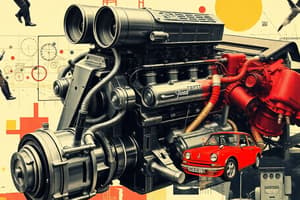Podcast
Questions and Answers
What technology replaced the steam engine in cars in the early 20th century?
What technology replaced the steam engine in cars in the early 20th century?
- Electric motors
- Direct injection
- Internal combustion engine (correct)
- Turbochargers
Which advancement in engine design allows for better control of airflow and combustion?
Which advancement in engine design allows for better control of airflow and combustion?
- Variable valve timing (correct)
- Direct injection
- Electric motors
- Turbochargers
What technology sends fuel directly into the engine's cylinder, increasing power and efficiency?
What technology sends fuel directly into the engine's cylinder, increasing power and efficiency?
- Variable valve timing
- Electric motors
- Turbochargers
- Direct injection (correct)
Which type of vehicles utilize rechargeable batteries to power electric motors?
Which type of vehicles utilize rechargeable batteries to power electric motors?
What engine technology enhances power output by forcing more air into the engine?
What engine technology enhances power output by forcing more air into the engine?
What makes Plug-in hybrid electric vehicles (PHEVs) different from Hybrid electric vehicles (HEVs)?
What makes Plug-in hybrid electric vehicles (PHEVs) different from Hybrid electric vehicles (HEVs)?
How does independent suspension improve car performance?
How does independent suspension improve car performance?
What is the main purpose of Forward collision warning (FCW) and Autonomous emergency braking (AEB)?
What is the main purpose of Forward collision warning (FCW) and Autonomous emergency braking (AEB)?
How do touchscreens and voice recognition systems benefit drivers?
How do touchscreens and voice recognition systems benefit drivers?
What technology enables cars to park themselves without a driver's assistance?
What technology enables cars to park themselves without a driver's assistance?
What is the core technology used by autonomous vehicles to navigate roads without human intervention?
What is the core technology used by autonomous vehicles to navigate roads without human intervention?
Flashcards are hidden until you start studying
Study Notes
Cars: A Journey Through Technology
From the first horse-drawn carthorse to the sleek electric vehicles of today, cars have evolved tremendously in terms of technology. This evolution has not only improved the efficiency and comfort of our rides but has also transformed our understanding of mobility. Let's delve into the fascinating world of car technology and explore the advancements that have shaped our automotive landscape.
Engine Technology
The internal combustion (IC) engine, which replaced the steam engine in the early 20th century, has been the foundation of propulsion for most cars. However, advancements in engine design have allowed for more power, greater fuel efficiency, and lower emissions.
- Turbochargers enhance power output by forcing more air into the engine, increasing fuel-air mixture, and raising the engine's performance without increasing its size.
- Variable valve timing allows for better control of airflow and combustion, improving fuel efficiency and power output.
- Direct injection sends fuel directly into the engine's cylinder, increasing power and efficiency.
Alternative Powertrains
Alternative powertrains, like electric and hybrid vehicles, are gaining popularity due to their environmental benefits and driving performance.
- Electric vehicles (EVs) utilize rechargeable batteries to power electric motors, producing zero emissions at the tailpipe.
- Hybrid electric vehicles (HEVs) use a combination of an IC engine and electric motors to provide better fuel efficiency.
- Plug-in hybrid electric vehicles (PHEVs) offer the advantages of both EVs and HEVs with the ability to recharge the battery from an external source.
Suspension and Steering Systems
Suspension and steering systems have also seen significant advancements, improving car handling, ride quality, and safety.
- Independent suspension allows each wheel to move individually, improving ride quality, handling, and safety.
- Electric power steering (EPS) utilizes an electric motor to assist the steering system, making steering lighter, more responsive, and more efficient.
Safety Systems
Safety has always been a top priority in the automotive industry, and technological advancements have made cars safer than ever.
- Advanced airbags include curtain airbags, knee airbags, and front center airbags to provide better protection in a collision.
- Electronic stability control (ESC) uses sensors to detect when a car is about to lose control and applies brakes or reduces power to specific wheels to maintain stability.
- Forward collision warning (FCW) and autonomous emergency braking (AEB) utilize radar or camera systems to detect potential collisions and apply brakes to prevent or lessen their impact.
- Blind-spot monitoring (BSM) and lane departure warning (LDW) use sensors to alert drivers of potential hazards in their blind spots or when they unintentionally drift from their lane.
Convenience and Infotainment
The latest cars now offer more convenience, entertainment, and connectivity through advanced infotainment systems.
- Touchscreens and voice recognition systems allow drivers to control car functions, entertainment options, and communication systems.
- Smartphone integration allows cars to connect to mobile devices, providing access to music, navigation, and communication apps.
- Remote access features allow car owners to lock, unlock, start, and check their vehicle's status remotely using their smartphones.
Autonomous Driving
Autonomous driving, or self-driving cars, is the next frontier of car technology.
- Autonomous vehicles utilize a combination of sensors, cameras, radar, and artificial intelligence to navigate roads, obey traffic laws, and make driving decisions without human intervention.
- Autonomous parking systems allow cars to park themselves without the need for a driver.
- Autonomous emergency braking systems can detect obstacles and apply brakes to prevent collisions.
In conclusion, cars have come a long way since their inception, with a host of technological advancements that have improved the driving experience, enhanced safety, and reduced environmental impact. As researchers and engineers continue to innovate, we can expect even more significant advancements in the world of car technology.
Studying That Suits You
Use AI to generate personalized quizzes and flashcards to suit your learning preferences.




